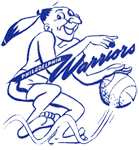Philadelphia Warriors

Historical Moments:
1946/47: With Guard “Jumpin’ Joe” Fulks winning the newly formed Basketball Association of America’s scoring title at 23.2 ppg, scoring nearly one-third his team’s points the Philadelphia Warriors make the playoffs by finishing in Eastern Divisions second spot with a 35-25 record. In the playoffs, the Warriors knocked off the St. Louis Bombers in three-game series that went the distance. The Warriors had just hit their stride beating the New York Knickerbockers in two straight games to make the first-ever BAA Finals. In the BAA Finals, the Warriors stayed hot, knocking off the Chicago Stags four games to one to claim the new league’s first Championship.
1947/48: With Joe Fulks leading the league in scoring average, the Warriors win the Eastern Division with a 27-21 record. In the semifinals, the Warriors survived a seven-game war with St. Louis Bombers overcoming three games to two deficit to make it back to the BAA Finals. However, perhaps the series took too much out of them as they fell to the Baltimore Bullets in six games.
1948/49: Joe Fulks once again sizzled as he was joined with Ed Sadowski in the league’s top five scorers. However, the Warriors struggled and just barely made the playoffs by finishing in fourth place with a 28-32 record. In the playoffs, the Warriors would fall quickly, losing two straight games to the Washington Capitols.
1949/50: In the first year the league was known as the NBA, the Warriors struggle again but make the playoffs by finishing in fourth place with a 26-42 record. In the playoffs, the Warriors are once again beaten in two straight games this time falling to the Syracuse Nationals.
1950/51: With Joe Fulks regaining his touch, the Warriors rebound and recapture the top spot in the Eastern Division with a 40-26 record. However, for the rd straight year, they are knocked out of the first round without winning a game, losing two straight games to the Syracuse Nationals for the second straight season.
1951/52: With Paul Arizin claiming the league’s scoring title with 25.4 ppg, the Warriors make the playoffs again by finishing in fourth place with a 33-33 record. However, for the third year in a row, the Warriors are knocked off by the Syracuse Nationals, this time extending the series the full three games.
1952/53: Despite Center Neil Johnston leading the NBA in scoring at 22.3 ppg, the Warriors struggle all season and finish dead last with an awful 12-57 record.
1953/54: Center Neil Johnston once again leads the NBA in scoring at 24.4 ppg, but it is not enough as the Warriors miss the playoffs for the second straight year by finishing in fourth place with a 29-43 record.
1954/55: Despite having the league’s top two scorers in Neil Johnston at 22.7 and Paul Arizin at 21.0, the Warriors continued to struggle finishing in last place with a 33-39 record.
1955/56: With George Senesky taking over for Ed Gottlieb as their coach, the Warriors jump out of the gate, quickly winning 12 of their first 16 games. Once again, Paul Arizin and Neil Johnston were among the league’s scoring leaders as the Warriors won the Eastern Division with a solid 45-27 record. However, it was the addition of Rookie Guard Tom Gola that made the difference in the transformation from last place to first place. In his first season, Gola averaged 9.1 rebounds and 5.9 assists per game. In the Eastern Division Finals, the Warriors beat the Syracuse Nationals in a hard-fought five-game series. In the NBA Finals, the Warriors found things easier as they impressively won their second Championship, beating the Fort Wayne Pistons four games to one.
1956/57: Coming off their World Championship, the Warriors struggled all season and just barely snuck into the playoffs holding off the New York Knicks by one point for the final playoff spot with a 37-35 record. In the playoffs, the Warriors would fall quickly, losing two straight games to the Syracuse Nationals.
1957/58: The Warriors play mediocre most of the season again, finishing in the third and final playoff spot with an identical 37-35 record. In the playoffs, the Warriors would face their nemesis the Syracuse Nationals again. However, this time they would rally to win Game 2 and take the series in three hard-fought games. However, there was no saving the Warriors in the Eastern Finals as they were mauled by the Boston Celtics four games to one.
1958/59: Despite Paul Arizin finishing third in scoring at 26.4 ppg, the Warriors fall into last place, missing the playoffs with a disappointing 35-37 record.
1959/60: Philadelphia High School legend Wilt Chamberlain joins the Warriors and dominates the league right away winning the Rookie of the Year, and NBA MVP, while leading the league in scoring (37.6) and rebounds (27.0). The addition of Wilt would lift the Warriors to second place where they finished with a solid 49-26 record. In the playoff, the Warriors would have to deal with Syracuse Nationals again, beating them in two games to one. The Eastern Finals saw a matchup of the league’s two best centers, but Bill Russell of the Boston Celtics would emerge victorious in six games.
1960/61: Wilt Chamberlain leads the league in scoring and rebounding again as the Warriors finish in second place with a 46-33 record. However, in the playoffs, the Warriors would be stunned by the Syracuse Nationals losing three straight games in the Eastern Semifinals.
1961/62: Wilt Chamberlain has perhaps the most dominant season in NBA history leading the league with an NBA record 50.4 ppg. In one eight-day stretch in January, Wilt Chamberlian notched three games where he scored at least 63 points. However, the best was yet to come. On March 2nd, playing the New York Knicks in Hershey, Pennsylvania, as Chamberlain had the most dominating game in NBA history, notching an incredible and unbreakable 100 points before 4,124 fans at the Warriors usual training facility. However, despite his dominance, Wilt would not win the NBA MVP losing out to Bill Russell just as the Warriors finished second behind Russell’s Boston Celtics with a 49-31 record. In the playoffs, the Warriors would be pushed to the limit by the Syracuse Nationals gain, finally emerging victorious in five games. This would set up a battle between Russell and Chamberlain in the Eastern Division Finals. Russell and Chamberlain would battle neck and neck for seven games, as the final game was knotted 107-107 in the final seconds. However, it would not be Russell but Sam Jones who hit the winning shot with two seconds remaining that broke hearts in Philadelphia.
1962: Following the season, the Warriors would move west to San Francisco, as Ed Gottlieb sold the team to a Bay Area Credit Card company, helping the extend professional basketball coast to coast. Philadelphia would only be without pro-basketball for one year, as the Syracuse Nationals who the Warriors battled seemingly every year in the playoffs moved to the city they vacated in 1963, becoming the Philadelphia 76ers.
©MMXIV Tank Productions. Stats researched by Frank Fleming, all information, and team names are property of the National Basketball Association. This site is not affiliated with the Philadelphia Warriors of the NBA. This site is maintained for research purposes only. All logos used on this page were from Chris Creamer’s Sports Logos Page.
Page created on September 30, 2002. Last updated on May 5, 2014 at 1:30 am ET.



